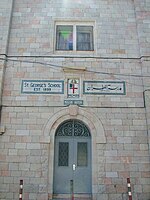2014 Jerusalem tractor attack
2014 in Jerusalem2014 murders in Asia2014 road incidentsAugust 2014 events in AsiaMurders by motor vehicle ... and 6 more
Terrorist incidents in Asia in 2014Terrorist incidents in JerusalemTerrorist incidents in Jerusalem in the 2010sTerrorist incidents involving vehicular attacksVehicular rampage in IsraelWikipedia extended-confirmed-protected pages
A terrorist ramming attack occurred on 4 August 2014, when a man drove an excavator type of tractor out of a construction site, injuring several pedestrians and killing one man before ramming the tractor into a public bus, overturning the bus and then hitting it repeatedly. The terrorist was shot dead at the scene by a police officer while still seated at the wheel of the tractor and continuing to attack the bus by swinging the arm of the excavator against it. The Jerusalem Post described it as part of a series of terrorist vehicular attacks in recent years.
Excerpt from the Wikipedia article 2014 Jerusalem tractor attack (License: CC BY-SA 3.0, Authors).2014 Jerusalem tractor attack
Jerusalem Beit Yisroel
Geographical coordinates (GPS) Address Nearby Places Show on map
Geographical coordinates (GPS)
| Latitude | Longitude |
|---|---|
| N 31.7897 ° | E 35.2254 ° |
Address
9522901 Jerusalem, Beit Yisroel
Jerusalem District, Israel
Open on Google Maps









